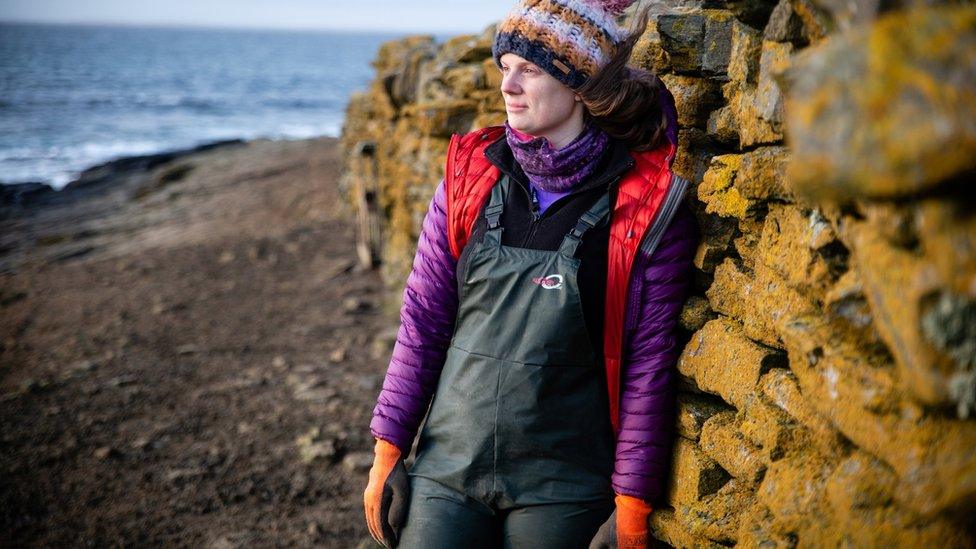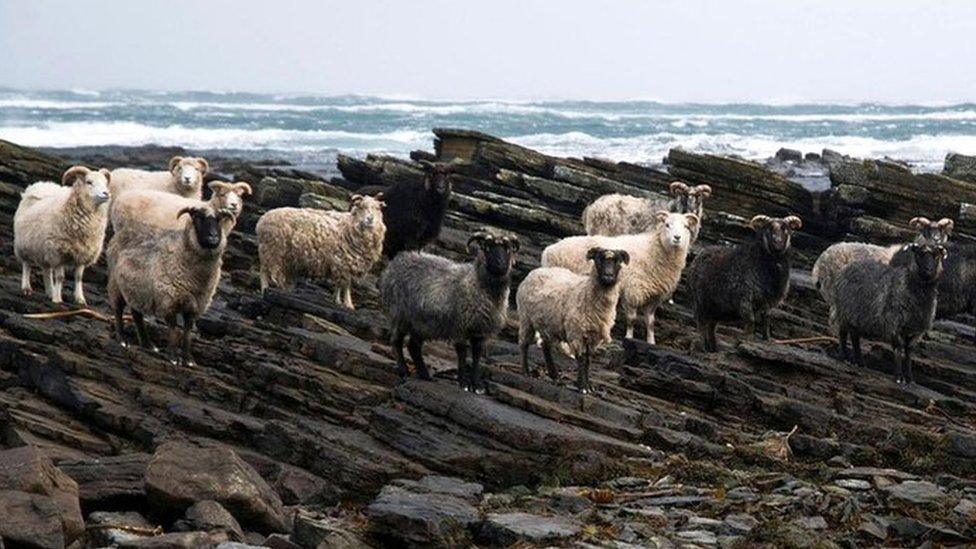The woman who will help keep seaweed-eating sheep on an Orkney beach
- Published

Sian Tarrant will look after North Ronaldsay's historic sheep dyke
A warden has been appointed to look after a historic dyke which keeps a rare breed of seaweed-eating sheep on the beach of an island in Orkney.
Sian Tarrant secured the job on North Ronaldsay after a search which prompted interest from around the world.
Her job will be to maintain the 19th Century stone wall.
It used to be maintained by the community, but that has become more difficult due to recent weather damage and a falling population on the island.
Sian, 28, said the job was "quite daunting" because so much of the dyke was in an "unfavourable state".

The North Ronaldsay sheep eat seaweed
But she said: "There's such a long history linking the islanders with the dyke. I hope that I can continue the labour of love, and repair it."
The structure, which is 6ft high and 13 miles long, was erected in the 1800s using beach stones.
It encircles the entire island to keep the sheep on the rocky foreshore.
The sheep are seen as a vital part of the island's economy due to the popularity of North Ronaldsay mutton and their wool.

Why do North Ronaldsay sheep eat seaweed?

The dyke encircles the island
North Ronaldsay sheep are an ancient breed which eat only seaweed for most of the year.
It is thought that they may originally have evolved to thrive on the diet due to the difficult winters and isolated location, which could have left them without grass for months on end.
As a result, they have adapted to absorb more of certain minerals, especially copper, from the seaweed.
The dyke was built in 1831 to preserve the island's inland pastures for other domestic animals.
This has prevented the sheep from mixing with other breeds, making them rare. They also feature on the Rare Breeds Survival Trust watchlist, external due to the low number of breeding females.
The sheep are only allowed inland during lambing season, which runs from May to August - but even then, some still stick to their seaweed-only diet.

Sian, who is originally from East Sussex, studied marine biology at St Andrews University and had been volunteering with the National Trust in North Devon.
"I wanted to find something outdoors because that's what I love doing, and I saw this come up," she told BBC Radio Orkney.

Sian said she had fallen in love with island life while working with seals in a number of places in Scotland, including the uninhabited Orkney island of Eynhallow.
She secured the job with an interview which took place over Skype while she was sitting in a car park in Snowdonia with her phone.
"It was really surreal. I don't know what the interview panel thought," she said.

Volunteers come to work on the dyke during a sheep festival
Alison Duncan from the North Ronaldsay Trust said Sian was "very well suited to the job".
She says the post, funded through the North Isles Landscape Partnership, will make "a huge difference" to maintaining the dyke.
"Pieces of it do come down every year, through weather or sea, and in the past there were many people around to build these places up again," she said.
"But in more recent years we've had bigger breaches of the dyke, and it's more difficult for just the folk on the island to build that up."
The community has tackled that problem by running an annual Sheep Festival, when volunteers come to work on the dyke.
Sian will work with the Sheep Festival, and said she also wanted to enlist people outside Orkney through things like volunteering and working holidays.
- Published17 June 2019

- Published16 August 2017
- Published1 November 2016
